Churches: Difference between revisions
ChurchesB12 (talk | contribs) |
ChurchesB12 (talk | contribs) No edit summary |
||
| Line 15: | Line 15: | ||
==History== | ==History== | ||
[[File:San Marco Churches.jpg|thumb|left|The Basilica of San Marco]]One of the reasons Venice has so many churches is that each island community in the city built its own place of worship, usually as a way of bringing the community together. | [[File:San Marco Churches.jpg|thumb|left|The Basilica of San Marco]]One of the reasons Venice has so many churches is that each island community in the city built its own place of worship, usually as a way of bringing the community together. Churches were often funded by wealthy merchants to showcase their wealth, by constructing dramatic interiors or elaborate façades. The oldest churches in the city were first established in the 9th century. While these church buildings are no longer standing, their traditions have continued through the years. In addition of old age, the churches of Venice have been subject to many disasters. In both the 11th and 15th centuries, fires burned through the city, destroying nearly all the buildings in their path. In the 15th century, the great fire in San Marco burned 21 churches to the ground. <ref>http.churchesofvenice.co.uk</ref> | ||
Another event in Venice’s history that affected many of the churches was Napoleon Bonaparte’s occupation of the city. | Another event in Venice’s history that affected many of the churches was Napoleon Bonaparte’s occupation of the city. In 1797, Napoleon took control of the Republic of Venice, and proceeded to suppress many churches and convents. Many of the churches he suppressed were able to reopen a couple of years later, however several were converted to military barracks or warehouse facilities and have not been restored to their original condition.<ref>http.churchesofvenice.co.uk</ref> Napoleon also ransacked several of the churches, and sold the art work that hung on their walls. Whether it has experienced one of these examples of city wide events, every church in Venice has a unique story to share. | ||
==Religious Services== | ==Religious Services== | ||
| Line 23: | Line 23: | ||
==Visiting Churches== | ==Visiting Churches== | ||
[[File:Chorus_Association.jpg|200px|right|Chorus Association Logo]]Many of the consecrated churches are open to the public, allowing visitors to view the art held inside. While admission to most is either free or by donations, some churches charge admission. There are 16 churches that are operated by the [[Chorus Association]] which all charge a fee for visits outside of service times | [[File:Chorus_Association.jpg|200px|right|Chorus Association Logo]]Many of the consecrated churches are open to the public, allowing visitors to view the art held inside. While admission to most is either free or by donations, some churches charge admission. There are 16 churches that are operated by the [[Chorus Association]] which all charge a fee for visits outside of service times. For more information of the Venetian [[Chorus Association]], visit the website in the [[Churches#External Links|External Links]] section. | ||
==Church Art== | ==Church Art== | ||
Much of the art | Much of the art seen in the churches of Venice was funded by wealthy families displaying their wealth to those around them. Donations to the churches were used to support local artists or workshops that would create pieces to showcase their skill in public places. | ||
[[File:EUFE_ceiling.JPG|thumb|left|An example of a painted ceiling in the | [[File:EUFE_ceiling.JPG|thumb|left|An example of a painted ceiling in the Church of Sant'Eufemia]] | ||
===Ceilings=== | ===Ceilings=== | ||
The ceilings of the churches of Venice range from a simple white plaster, to carved | The ceilings of the churches of Venice range from a simple white plaster, to carved boat hulls, to paintings or frescoes. Some of these paintings are elaborate and cover the entire ceiling, giving a sense of depth on a flat surface. Otherwise unused space, the church ceilings provide a large surface for intricate paintings. The center painting in the [[Church of Sant'Eufemia]] is seen to the left. | ||
===Paintings=== | ===Paintings=== | ||
Catholic churches | Catholic churches contain 14 images known as the Stations of the Cross. These scenes chronicle the events of Easter weekend. This story can be told thorough stain glass windows, wood carvings or paintings. Paintings are a simple way to showcase wealth of an area based on the influence and fame of the artist. Additionally, many of the side altars in churches are adorned with paintings of religious figures or Biblical scenes. | ||
[[File:Santa Maria della Salute altar.JPG|thumb|right|The altar of the | [[File:Santa Maria della Salute altar.JPG|thumb|right|The altar of the Church of La Salute]] | ||
===Altars=== | ===Altars=== | ||
The main altar of a | The main altar of a church is located at the front of the church and is where mass itself takes place. Altars can be simple tables or intricate stone pieces with carved figures on the front and sides telling a story or supporting the top of the altar. In addition to the main altar, smaller, side altars are sometimes added to larger churches where mass can be said in a more intimate setting. The main altar of the [[Church of La Salute]] is pictured right. | ||
===Church Floors=== | ===Church Floors=== | ||
Floors are generally the last place someone looks for art, but in Venice, this is hardly the case. Of the 139 churches in Venice, 74 contain artifacts amounting to 2221 floor artifacts categorized as either tombs or plaques. <ref>Dechaine, Danielle, Hennessey, Meghan, Orszulak, Jeffrey, Rullmann, Kevin. Treasures Underfoot: Preserving Venice's Church Floor Artifacts. An Interactive Qualifying Project for Worcester Polytechnic Institute. 2012.</ref> These [[Church Floor Artifacts]] contain valuable information in their inscriptions that provide a glimpse into the Venetian history. | Floors are generally the last place someone looks for art, but in Venice, this is hardly the case. Of the 139 churches in Venice, 74 contain artifacts amounting to 2221 floor artifacts categorized as either tombs or plaques.<ref>Dechaine, Danielle, Hennessey, Meghan, Orszulak, Jeffrey, Rullmann, Kevin. Treasures Underfoot: Preserving Venice's Church Floor Artifacts. An Interactive Qualifying Project for Worcester Polytechnic Institute. 2012.</ref> These [[Church Floor Artifacts]] contain valuable information in their inscriptions that provide a glimpse into the Venetian history. Several churches contain tombs of Doges, former rulers of Venice, and other wealthy citizens. These tombs help visitors to gain a better understanding of the age of the church they are in and its significance to the city’s history. After hundreds of years of people walking on the floors coupled with the ''acqua alta'' floods that Venice is famous for, these artifacts are in danger of being worn away. Preservation efforts of the inscriptions are important to maintain the history of the churches. | ||
==Church Preservation== | ==Church Preservation== | ||
The churches of Venice house 2221 [[Church Floor Artifacts]], which undergo wear and tear on a daily basis. | The churches of Venice house 2221 [[Church Floor Artifacts]], which undergo wear and tear on a daily basis. Since these artifacts are made of stone, they are durable, but over several centuries, the text or images carved into the artifact is worn smooth. The [[Soprintendenza]] is a branch of the Ministry of Heritage and Cultural Activities, an Italian government organization that oversees all restoration efforts involving culturally significant artifacts across Italy. They have isolated four categories of culturally significant artifacts including archives, monuments, works of art, and archaeology. If a building, monument, or piece of art is in one of these categories, the [[Soprintendenza]] dictates all restoration projects that the item may undergo, regardless of if the item is publicly or privately owned. Church floor artifacts are categorized as monuments, and therefore receive preservation funds from the [[Soprintendenza]]. Typically, several small projects are carried out each year, such as cleaning a façade or replacing the roof a church, in Venice alone, even though the [[Soprintendenza]] is responsible for all of Italy. The majority of their funding comes from tax donations call the ''otto mille''. This donation takes an additional 0.008% of your taxes and applies the money towards restoration projects for various churches across Italy. <ref>Soprintendenza B.A.P. di Venezia e Laguna. 2012. 7 Oct 2012 <http://www.soprintendenza.venezia.beniculturali.it/></ref> | ||
The United Nations Educational, Scientific, and Cultural Organization, [[UNESCO]], is a second platform for providing funding to restore churches. Around the globe, there are nearly twenty private organizations dedicated to funding preservation projects for Venice. Annually, [[UNESCO]] sends these organizations the [[Soprintendenza]]’s request list to determine which projects they will be funding for the following year. After their decision has been made, they make a donation to [[UNESCO]] in order for their desired project to be carried out | The United Nations Educational, Scientific, and Cultural Organization, [[UNESCO]], is a second platform for providing funding to restore churches. Around the globe, there are nearly twenty private organizations dedicated to funding preservation projects for Venice. Annually, [[UNESCO]] sends these organizations the [[Soprintendenza]]’s request list to determine which projects they will be funding for the following year. After their decision has been made, they make a donation to [[UNESCO]] in order for their desired project to be carried out. Worcester Polytechnic Institute project teams have worked tangent to [[UNESCO]] to catalog the progress of these restoration projects, and make a record of all the artifacts that lie in the floors of Venice's churches.<ref>UNESCO-ROSTE. " Historical Facts: Introductory Notes about the Regional Bureau for Science in Europe Starting from the Disastrous Flooding of 1966 Till Today." accessed September 8, 2012.</ref> | ||
==Statistics== | ==Statistics== | ||
Revision as of 22:14, 26 December 2012
 |
Churches, or chiese in Italian, are a common feature in most squares, or campi, throughout the city of Venice. There are 139 churches in the city, including a few recognizable landmarks, such as Church of Frari, Church of Miracoli, and the Basilica of San Marco (Church) pictured on the right. Some of the larger churches have become tourist attractions in the city of Venice. The most commonly visited church is Basilica of San Marco (Church), however many others are open to the public daily. Several churches are open for free or ask for donations, however 16 are run by the Chorus Association, an organization that is responsible for the maintenance of select churches in the city, charges a small fee for entrance.
History
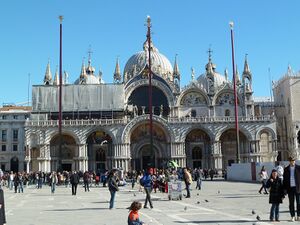
One of the reasons Venice has so many churches is that each island community in the city built its own place of worship, usually as a way of bringing the community together. Churches were often funded by wealthy merchants to showcase their wealth, by constructing dramatic interiors or elaborate façades. The oldest churches in the city were first established in the 9th century. While these church buildings are no longer standing, their traditions have continued through the years. In addition of old age, the churches of Venice have been subject to many disasters. In both the 11th and 15th centuries, fires burned through the city, destroying nearly all the buildings in their path. In the 15th century, the great fire in San Marco burned 21 churches to the ground. [1]
Another event in Venice’s history that affected many of the churches was Napoleon Bonaparte’s occupation of the city. In 1797, Napoleon took control of the Republic of Venice, and proceeded to suppress many churches and convents. Many of the churches he suppressed were able to reopen a couple of years later, however several were converted to military barracks or warehouse facilities and have not been restored to their original condition.[2] Napoleon also ransacked several of the churches, and sold the art work that hung on their walls. Whether it has experienced one of these examples of city wide events, every church in Venice has a unique story to share.
Religious Services
While there are 139 church buildings in the city of Venice, only 88 of them are still practicing churches that hold mass at least once a week. The other 51 churches have been converted to other uses such as schools, museums or storage facilities. The map below shows the location of the 88 practicing churches in Venice in green, not including 12 located on the Lagoon islands. For information on church service times, visit the See Also section below.
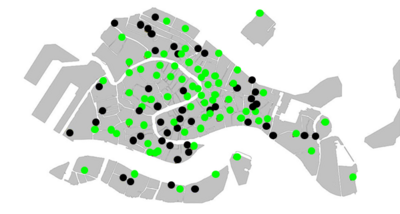
Visiting Churches
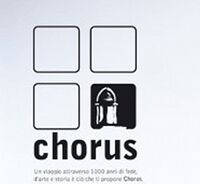
Many of the consecrated churches are open to the public, allowing visitors to view the art held inside. While admission to most is either free or by donations, some churches charge admission. There are 16 churches that are operated by the Chorus Association which all charge a fee for visits outside of service times. For more information of the Venetian Chorus Association, visit the website in the External Links section.
Church Art
Much of the art seen in the churches of Venice was funded by wealthy families displaying their wealth to those around them. Donations to the churches were used to support local artists or workshops that would create pieces to showcase their skill in public places.
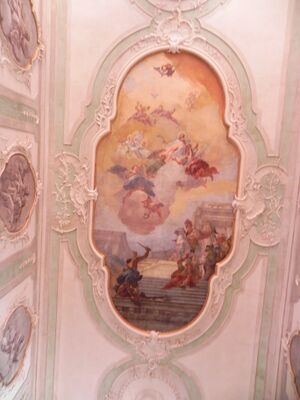
Ceilings
The ceilings of the churches of Venice range from a simple white plaster, to carved boat hulls, to paintings or frescoes. Some of these paintings are elaborate and cover the entire ceiling, giving a sense of depth on a flat surface. Otherwise unused space, the church ceilings provide a large surface for intricate paintings. The center painting in the Church of Sant'Eufemia is seen to the left.
Paintings
Catholic churches contain 14 images known as the Stations of the Cross. These scenes chronicle the events of Easter weekend. This story can be told thorough stain glass windows, wood carvings or paintings. Paintings are a simple way to showcase wealth of an area based on the influence and fame of the artist. Additionally, many of the side altars in churches are adorned with paintings of religious figures or Biblical scenes.
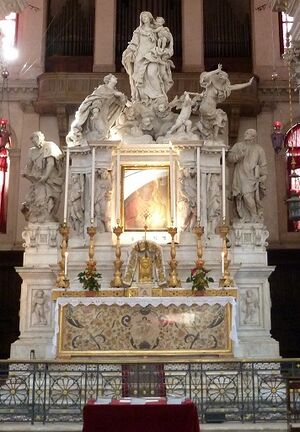
Altars
The main altar of a church is located at the front of the church and is where mass itself takes place. Altars can be simple tables or intricate stone pieces with carved figures on the front and sides telling a story or supporting the top of the altar. In addition to the main altar, smaller, side altars are sometimes added to larger churches where mass can be said in a more intimate setting. The main altar of the Church of La Salute is pictured right.
Church Floors
Floors are generally the last place someone looks for art, but in Venice, this is hardly the case. Of the 139 churches in Venice, 74 contain artifacts amounting to 2221 floor artifacts categorized as either tombs or plaques.[3] These Church Floor Artifacts contain valuable information in their inscriptions that provide a glimpse into the Venetian history. Several churches contain tombs of Doges, former rulers of Venice, and other wealthy citizens. These tombs help visitors to gain a better understanding of the age of the church they are in and its significance to the city’s history. After hundreds of years of people walking on the floors coupled with the acqua alta floods that Venice is famous for, these artifacts are in danger of being worn away. Preservation efforts of the inscriptions are important to maintain the history of the churches.
Church Preservation
The churches of Venice house 2221 Church Floor Artifacts, which undergo wear and tear on a daily basis. Since these artifacts are made of stone, they are durable, but over several centuries, the text or images carved into the artifact is worn smooth. The Soprintendenza is a branch of the Ministry of Heritage and Cultural Activities, an Italian government organization that oversees all restoration efforts involving culturally significant artifacts across Italy. They have isolated four categories of culturally significant artifacts including archives, monuments, works of art, and archaeology. If a building, monument, or piece of art is in one of these categories, the Soprintendenza dictates all restoration projects that the item may undergo, regardless of if the item is publicly or privately owned. Church floor artifacts are categorized as monuments, and therefore receive preservation funds from the Soprintendenza. Typically, several small projects are carried out each year, such as cleaning a façade or replacing the roof a church, in Venice alone, even though the Soprintendenza is responsible for all of Italy. The majority of their funding comes from tax donations call the otto mille. This donation takes an additional 0.008% of your taxes and applies the money towards restoration projects for various churches across Italy. [4]
The United Nations Educational, Scientific, and Cultural Organization, UNESCO, is a second platform for providing funding to restore churches. Around the globe, there are nearly twenty private organizations dedicated to funding preservation projects for Venice. Annually, UNESCO sends these organizations the Soprintendenza’s request list to determine which projects they will be funding for the following year. After their decision has been made, they make a donation to UNESCO in order for their desired project to be carried out. Worcester Polytechnic Institute project teams have worked tangent to UNESCO to catalog the progress of these restoration projects, and make a record of all the artifacts that lie in the floors of Venice's churches.[5]
Statistics
There are 139 churches located within Venice and its Lagoon. The Religious Denominations of the churches, Active Churches, and Churches with Floor Artifacts are described below.
Religious Denominations
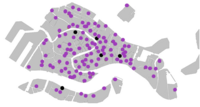

Of the 139 Churches in Venice, 96% (133) of them are currently, or were at one time, Catholic. The six churches of other denominations are Evangelical Lutheran Church, Lutheran, Church of Greci, Greek Orthodox, Church of St. George, Anglican, Church of Sant'Eufemia, Presbyterian, Church of Santa Croce degli Armeni, Armenian, and Church of San Zandegola, Russian Orthodox.
Active Churches
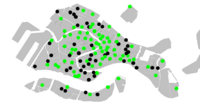

Today, 88 of the 139 church buildings in the city of Venice are still functioning churches that hold religious celebrations at least once a week. The other 51 churches in Venice and the Lagoon islands have been converted to other used such as school, community buildings or storage facilities.
Churches with Floor Artifacts
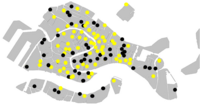

Of the 139 churches in Venice, 74, or 54% of the church buildings in Venice house artifacts that have been assessed. The remaining 65 churches either do not contain artifacts, or the floor could not be viewed to determine if artifacts are present.
Map
This map shows the location of all the churches of Venice, excluding the 19 located on the Lagoon islands. <display_map height=600 zoom=14 centre=45.440155,12.345403> 45.265582,12.300881|Church of Ognissanti di Pellestrina 45.27445,12.301168|Church of Santi Vito e Modesto in Pellestrina 45.282621,12.302482|Church of San Antonio 45.432203,12.311178|Church of Santa Marta 45.42692,12.314087|Church of San Gerardo 45.432596,12.315829|Church of San Nicolo dei Mendicoli 45.317496,12.315974|Church of San Pietro 45.438393,12.316176|Church of La Zirada 45.433282,12.316219|Church of Le Teresa 45.439357,12.316498|Church of Nome di Gesu 45.435149,12.316842|Church of Santa Maria Maggiore 45.432563,12.318999|Church of L'Anzolo Rafael 45.447246,12.319101|Church of Le Penitenti 45.431996,12.320083|Church of San Sebastiano 45.4453,12.320104|Church of San Giobbe 45.426013,12.321727|Church of San Convertite 45.437806,12.321831|Church of Tolentini 45.441437,12.322011|Church of Gli Scalzi 45.433754,12.322091|Church of Carmini 45.425716,12.323046|Church of San Cosmo 45.43139,12.323435|Church of Ognisanti 45.426919,12.323616|Church of Sant'Eufemia 45.447246,12.323993|Church of Le Cappuccine 45.435309,12.324047|Church of Santa Margherita 45.440825,12.324395|Church of San Simeon Grando 45.440863,12.324416|Church of San Simeon Piccolo 45.432053,12.324449|Church of Le Romite 45.435999,12.32449|Church of San Pantalon 45.446794,12.325023|Church of San Girolomo 45.442725,12.325268|Church of San Geremia 45.433209,12.325297|Church of San Barnaba 45.436997,12.325308|Church of San Rocco 45.445719,12.325753|Suore Dorotee 45.430902,12.325918|Church of San Trovaso 45.438214,12.326034|Church of San Giovanni Evangelista 45.429743,12.326594|Church of Santa Maria della Visitazione 45.437114,12.326665|Church of Frari 45.443994,12.32674|Church of San Leonardo 45.447935,12.326754|Church of San Bonaventura 45.429404,12.327164|Church of Gesuati 45.440306,12.327367|Church of San Giacomo dell'Orio 45.43596,12.327752|Church of San Tommaso 45.441751,12.327774|Church of San Zandegola 45.429983,12.328113|Church of Sant'Agnese 45.433627,12.328299|Church of San Samuele 45.431407,12.328583|Church of La Carità 45.443226,12.328588|Church of San Marcuola 45.448149,12.329014|Church of Sant'Alvise 45.432436,12.329398|Church of S. Vidal 45.43721,12.329532|Church of San Polo 45.430722,12.330103|Church of Santi Vito e Modesto 45.430827,12.330345|Church of St. George 45.440238,12.330371|Church of Maria Mater Domini 45.441525,12.330671|Church of San Stae 45.425518,12.330747|Church of San Trinità 45.444103,12.330882|Church of Servi 45.43372,12.331042|Church of San Stefano 45.443204,12.331122|Church of La Maddalena 45.433087,12.33157|Church of San Maurizio 45.428644,12.331729|Church of Spirito Santo 45.43427,12.331866|Oratorio dell'Annunciata 45.439702,12.332063|Church of San Cassian 45.443051,12.33218|Church of Santa Fosca in Cannaregio 45.425212,12.332451|Church of Redentore 45.435834,12.332463|Church of San Benedetto 45.437964,12.332507|Church of Sant'Aponal 45.446591,12.332526|Church of La Madonna dell'Orto 45.43274,12.332753|Church of Santa Maria Zobenigo 45.44388,12.33288|Church of San Marziale 45.441723,12.333379|Church of San Felice 45.437553,12.333396|Church of San Silvestro 45.435839,12.333649|Church of San Luca 45.43079,12.33369|Church of San Gregorio 45.430179,12.334035|Church of Catecumeni 45.433989,12.334094|Church of San Fantin 45.438711,12.334383|Church of San Giovanni Elemosinario 45.43102,12.334754|Church of La Salute 45.441087,12.335001|Church of Santa Sofia 45.424921,12.33516|Church of La Croce 45.443966,12.335173|Church of La Misericordia 45.438598,12.33531|Church of San Giacometo di Rialto 45.433134,12.336048|Church of San Moisè 45.437731,12.336229|Church of San Bartolomeo 45.440265,12.336308|Evangelical Lutheran Church 45.443408,12.336375|Church of Santa Caterina 45.43688,12.336506|Church of San Salvador 45.434727,12.336829|Church of San Gallo 45.439155,12.337227|Church of San Giovanni Grisostomo 45.371726,12.337764|Church of Santa Maria dell'Assunzione 45.435638,12.33772|Church of Santa Croce degli Armeni 45.437064,12.338003|Church of La Fava 45.437617,12.33846|Church of San Lio 45.440161,12.338539|Church of San Canciano 45.435956,12.338582|Church of San Zulian 45.427108,12.339125|Church of Le Zitelle 45.439566,12.339194|Church of Miracoli 45.443633,12.339254|Church of Gesuiti 45.435141,12.339329|Church of San Basso 45.434644,12.339458|Basilica of San Marco (Church) 45.434984,12.340259|Church of San Teodoro 45.437162,12.341047|Church of Santa Maria Formosa 45.435737,12.341462|Church of San Zaninovo 45.43959,12.34153|Church of San Zanipolo 45.4414,12.342468|Church of Mendicanti 45.429642,12.342646|Church of San Giorgio 45.438842,12.342818|Church of L'Ospedalletto 45.434724,12.343557|Church of San Zaccaria 45.435571,12.344636|Church of Greci 45.434311,12.344963|Church of La Pietà 45.440155,12.345403|Church of Santa Maria del Pianto 45.437492,12.345451|Church of San Lorenzo 45.43621,12.345968|Church of San Giorgio degli Schiavoni 45.438268,12.345993|Church of Santa Giustina 45.436643,12.346229|Church of San Giovanni di Malta 45.43569,12.346412|Church of San Antonin 45.434455,12.346797|Church of La Bragora 45.449286,12.346882|Church of San Michele 45.438457,12.347661|Church of La Vigna 45.458683,12.348777|Church of Santa Maria degli Angeli 45.434662,12.348949|Church of San Martino 45.433755,12.348971|Church of Ca' di Dio 45.432676,12.349989|Church of San Biagio 45.45502,12.352626|Church of San Pietro Martire 45.432958,12.354037|Church of San Francesco di Paula 45.432767,12.356446|Church of San Gioacchino 45.430633,12.357167|Church of San Giuseppe 45.457527,12.357232|Church of San Donato 45.432676,12.358138|Church of Sant'Anna 45.434805,12.359779|Church of San Pietro di Castello 45.403661,12.361806|Church of San Antonio 45.426414,12.362834|Suore Mantellate 45.427108,12.365374|Church of Sant'Elena 45.417266,12.368855|Church of Santa Maria Elisabetta 45.442332,12.377429|Church of Sant'Erosia 45.427877,12.380692|Church of San Nicolò 45.484041,12.405809|Church of Santa Caterina 45.459179,12.410323|Church of Sant'Erasmo 45.498368,12.418744|Church of Santa Fosca in Torcello 45.484688,12.41875|Church of San Martino 45.498594,12.41912|Church of Santa Maria Assunta </display_map>
See Also
References
- ↑ http.churchesofvenice.co.uk
- ↑ http.churchesofvenice.co.uk
- ↑ Dechaine, Danielle, Hennessey, Meghan, Orszulak, Jeffrey, Rullmann, Kevin. Treasures Underfoot: Preserving Venice's Church Floor Artifacts. An Interactive Qualifying Project for Worcester Polytechnic Institute. 2012.
- ↑ Soprintendenza B.A.P. di Venezia e Laguna. 2012. 7 Oct 2012 <http://www.soprintendenza.venezia.beniculturali.it/>
- ↑ UNESCO-ROSTE. " Historical Facts: Introductory Notes about the Regional Bureau for Science in Europe Starting from the Disastrous Flooding of 1966 Till Today." accessed September 8, 2012.
Bibliography
- Dechaine, Danielle, Hennessey, Meghan, Orszulak, Jeffrey, Rullmann, Kevin. Treasures Underfoot: Preserving Venice's Church Floor Artifacts. An Interactive Qualifying Project for Worcester Polytechnic Institute. 2012.
- Lorenzetti, Giulio. “Venice and its Lagoon: Historical-Artistic Guide” Edizoni LINT S.R.L. Italy. 1994
- Mandonnet, P. (1911). Order of Preachers. In The Catholic: Robert Appleton Company. Retrieved December 4, 2012 from New Advent: <http://www.newadvent.org/cathen/12354c.htm>
- S. Hoey, M. Kahan, P Marchetti, K Mazza. Convents, Palaces and Churches: Transformation of Historic Buildings and the Impact on Venice’s Neighborhoods. An Interactive Qualifying Project for Worcester Polytechnic Institute. 2003.
- Santos,Luiz G., Petrowski,Craig Peter, Kristant,Elaine Hazel, Delaive,Amanda Leigh. The Church Floors in Venice, Italy -- an Archeological Study and Analysis. An Interactive Qualifying Project for Worcester Polytechnic Institute. 2002.
- Soprintendenza B.A.P. di Venezia e Laguna. 2012. 7 Oct 2012 <http://www.soprintendenza.venezia.beniculturali.it/>